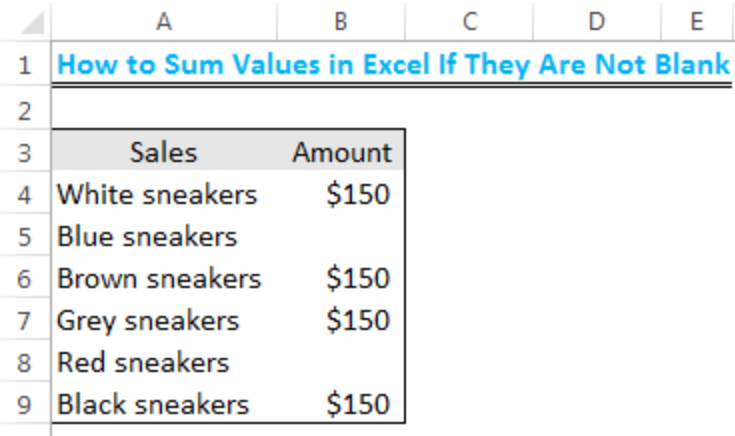We can sum cells when certain values are not blank. We can do this with the SUMIF function. This step by step tutorial will guide all levels of Excel users through summing all non-blank values.
 Figure 1: Result of Summed Values that are not blank
Figure 1: Result of Summed Values that are not blank
Setting up the Data
- We will set up our data by inputting the SALES and AMOUNT in Column A and Column B respectively
 Figure 2: Setting up the Data
Figure 2: Setting up the Data
Formula
=SUMIF(A4:A9,"<>",B4:B9)
Syntax
=SUMIF(range,"<>",sum_range)
Explanation
With this formula, we will sum the amounts in Column B provided the corresponding Cell in Column A is not blank.
The criteria “<>” is used to indicate cells that are not empty.
Summing the Values
- We will name Cell C5 as Sales with Amount
 Figure 3: Summing Values that are not blank
Figure 3: Summing Values that are not blank
- We will input the formula into Cell D5;
=SUMIF(A4:A9,"<>",B4:B9)
 Figure 4: Summing Values that are not blank
Figure 4: Summing Values that are not blank
- Now, we will press ENTER
 Figure 5: Result of Summed Values that are not blank
Figure 5: Result of Summed Values that are not blank
Instant Connection to an Expert through our Excelchat Service
Most of the time, the problem you will need to solve will be more complex than a simple application of a formula or function. If you want to save hours of research and frustration, try our live Excelchat service! Our Excel Experts are available 24/7 to answer any Excel question you may have. We guarantee a connection within 30 seconds and a customized solution within 20 minutes.














Leave a Comment